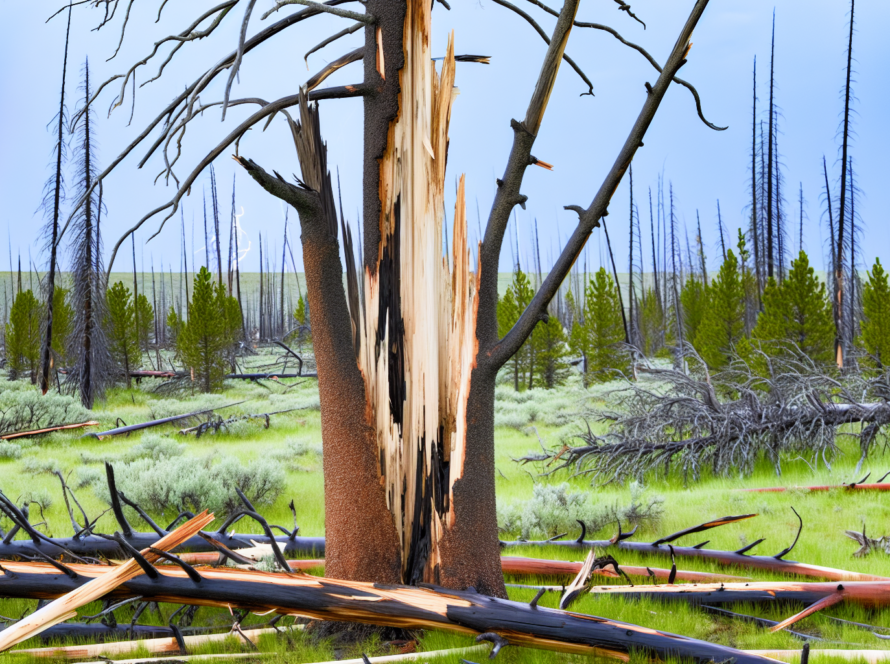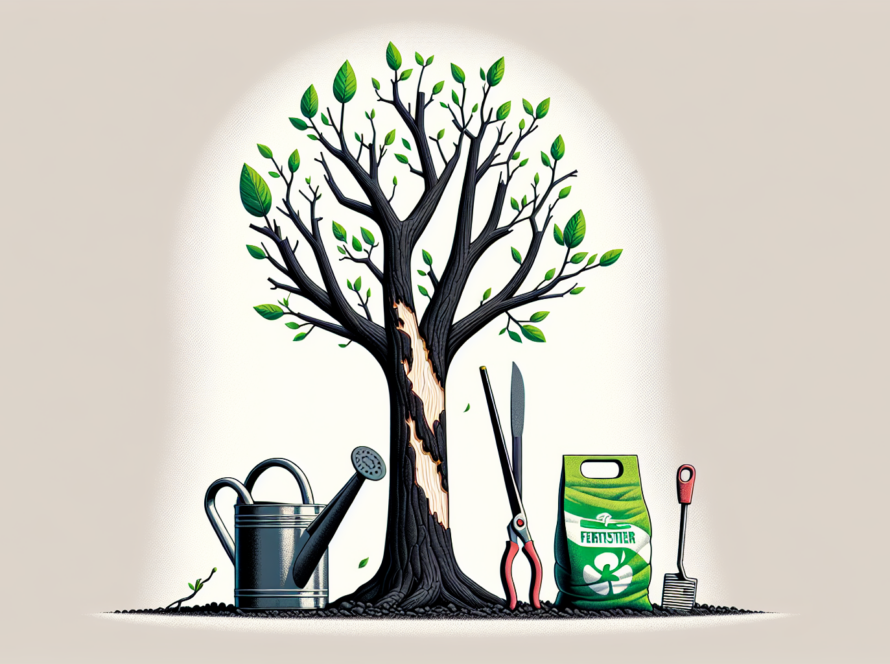Battling tree diseases is crucial for the health of our trees and the environments they support. Discover how to spot the signs of tree ailments, from fungi-infected roots to bacteria-laden leaves, and what steps to take to protect and heal your trees. This guide offers a deep dive into the causes of tree diseases, their effects on our natural world, and practical prevention and treatment strategies. Stay ahead of tree diseases with the insights you’ll gain here.
Key Takeaways
Tree diseases have biotic and abiotic origins and their impact extends beyond individual trees, affecting ecosystems and industries dependent on tree products.
Effective prevention and management of tree diseases involve proper tree selection, cultivation, pruning, sanitation, and ecosystem management to enhance species diversity and resilience.
Advanced research and techniques, including genome-wide association studies, gene editing, and ecosystem-level strategies, are crucial for developing disease resistance and preserving long-term forest health.
Understanding Tree Diseases: Origins and Impact

Tree diseases are not random events. Instead, they indicate a deviation or malfunction caused by a persistent agent impacting tree health. The culprits behind these ailments can be broadly categorized into two types: abiotic factors like drought and mechanical damage, and biotic elements, such as pathogens. Diseases caused by living organisms, known as biotic diseases, are categorized according to the type of pathogen they are caused by. These include:
Bacteria
Fungi
Viruses
Phytoplasmas
Nematodes
However, the impact of tree diseases extends far beyond the health of individual trees. They have far-reaching implications, affecting industries reliant on tree products and fulfilling environmental needs. From the lumber for our homes to the paper for our books, trees play a crucial role in our lives. Hence, the understanding of tree diseases’ origins and effects isn’t solely about preserving an individual tree’s health; it’s about protecting entire ecosystems and industries.
The Culprits Behind Tree Ailments
Biotic factors causing tree diseases include living organisms like:
insects
fungi
diseases
animals
Some biotic diseases are tree specific, preferring only certain species of trees. For example, the Tulip Scale disease is specific to the Tulip Poplar. However, nearly all decay in trees is caused by fungi. From the rust fungi to the bark beetles and the Armillaria root rot, these pathogens pose a significant threat to the health of trees.
Armillaria root rot, for instance, is a common hardwood root disease that is often lethal to trees. It’s not uncommon for a tree to be affected by both biotic and abiotic disorders, as stress from damage can make a tree more susceptible to disease. Hence, acquiring a comprehensive understanding of these culprits paves the way for formulating efficient prevention and control strategies.
The Consequences of Infection
Tree diseases can have devastating consequences. Take Fusiform Rust, for instance. This disease can lead to death within five years of a tree’s life due to stem infections, causing significant economic losses. Every year, diseases like Fusiform Rust cause timber growers to lose millions of dollars. This loss has a significant impact on the industry..
Moreover, tree diseases have a significant impact on tree mortality rates and prevent proper water and nutrient absorption. For example, Lodgepole pines affected by dwarf mistletoe experience severe growth loss, contributing to a higher mortality rate. In urban environments, the decline or death of shade trees due to diseases like anthracnose can lead to reduced property values.
On the other hand, in certain ecological contexts, the death of trees can lead to forest regeneration and increased diversity, highlighting an ecological benefit of tree diseases.
Recognizing Symptoms: Identifying Common Tree Diseases
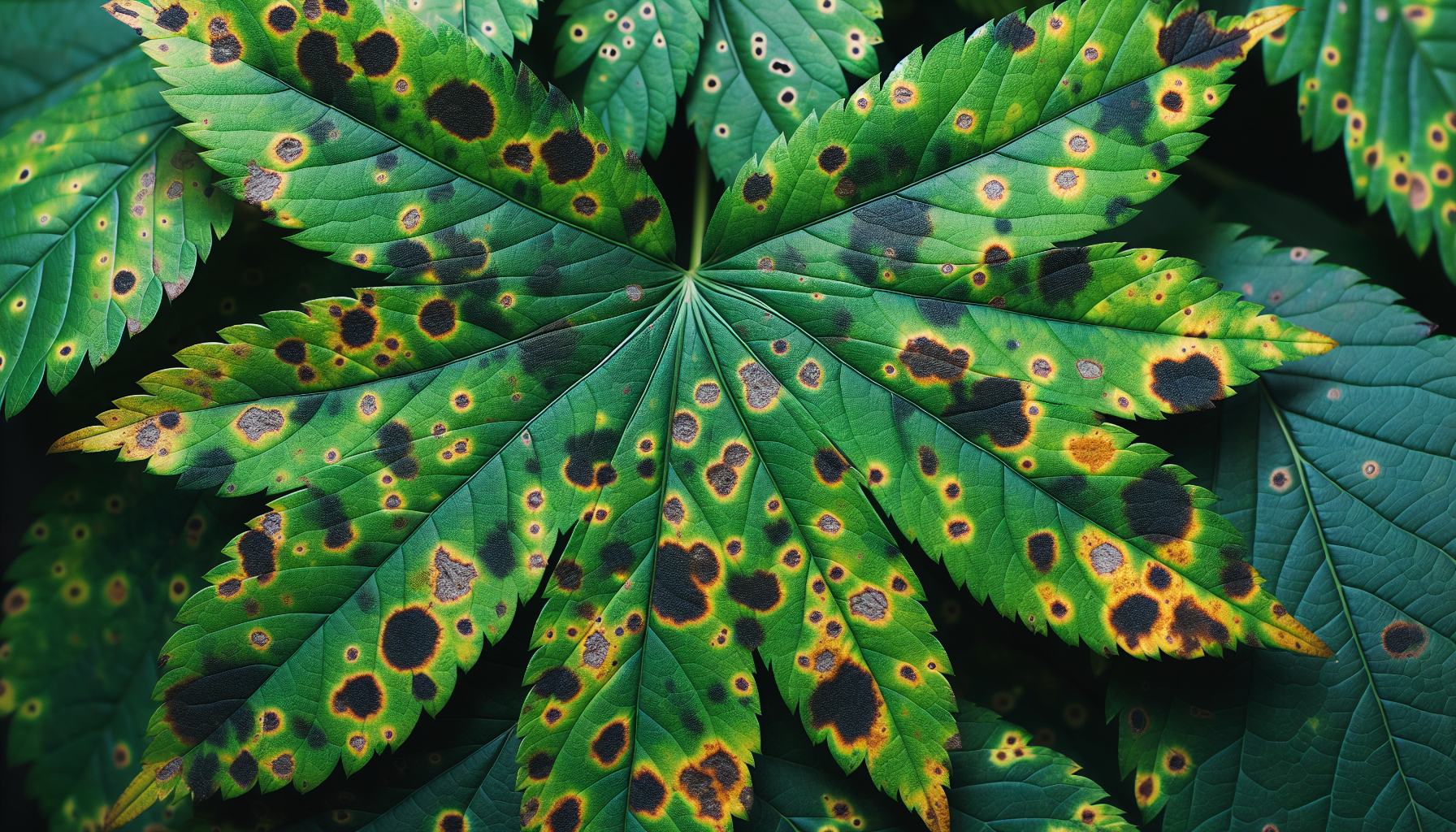
Just as a doctor diagnoses a patient by observing their symptoms, so too can a tree’s health be assessed by identifying the signs of disease. Some common symptoms of tree diseases include:
Leaf spots
Wilting
Cankers
Root rot
These symptoms can signal the presence of common tree diseases, including those affecting ash trees.
Leaf spots appearing as dead areas on foliage can be a sign of common diseases and potentially lead to defoliation and death of twigs and branches. Blights and diebacks involve noticeable damage to leaves and tips, with wilting and death of shoots, worsening in wet conditions.
Wilts in trees result in droopy and yellow foliage, premature leaf drop, and sometimes a prolific production of seeds. Identifying these symptoms is vital for prompt intervention and treatment, which guarantees our trees’ health and longevity.
Foliage Afflictions: Spotting Leaf and Needle Issues
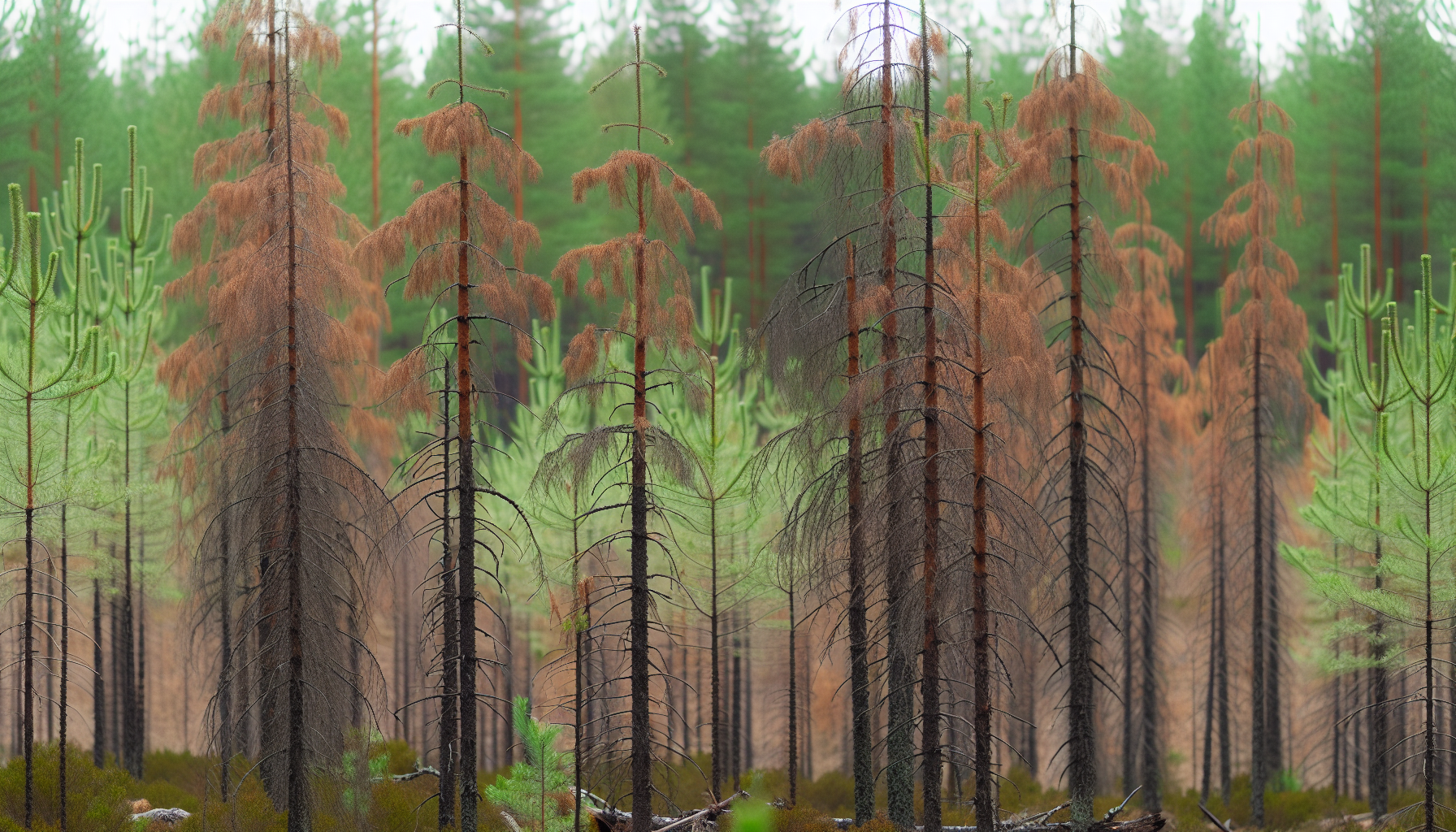
One of the first places to spot the signs of tree disease is in the foliage. Common foliar diseases such as leaf spots and anthracnoses manifest as leaf spots, shoot blight, and sometimes defoliation. Certain fungal diseases can lead to early leaf shedding, affecting overall plant development and growth, which is crucial in young tree stages in nurseries.
Needle blight and needle cast diseases, both types of pine needle diseases, cause symptoms like brown spots on pine needles leading to browning and defoliation, often affecting conifers such as Blue Spruce and longleaf pines within nurseries and natural ranges.
Rust diseases, a type of hardwood leaf diseases, appear as yellow spots on the upper surfaces of leaves of hardwood species, with powdery spores indicating infection, which is influenced by factors such as succulent leaf tissue and dry, warm weather. These symptoms can be easily confused with powdery mildew, another common plant disease.
Stem and Branch Troubles: Canker Diseases and More
Aside from foliage, the stem and branches of a tree often bear the brunt of disease, affecting the entire tree. Cankers, which are localized areas of dead bark and wood, may appear as circular or oblong lesions, discolored, oozing, or sunken with a distinct margin, and can girdle stems or trunks leading to wilting foliage and eventual plant death.
Most stem diseases, including fungal disease, are caused by fungal pathogens which block the tree’s vascular system when they invade. Canker diseases, such as those caused by Botryosphaeria or Cytospora, can severely affect merchantable hardwood timber, resulting in significant economic losses and compromised tree health.
Management of canker diseases involves practices such as removal of infected branches to save the tree, and understanding that wounds are prevalent entry points for the pathogens resulting in these diseases.
Root Woes: Understanding Pine Root Diseases and Others
The roots of a tree, though often out of sight, should not be out of mind. Diseases like annosus root and butt rot and littleleaf disease can have severe impacts on a tree’s health. Diagnosing root diseases can be difficult because they develop in the unseen parts of the tree, often remaining undetected until significant damage has occurred, which is a challenge highlighted by diseases such as annosus root and butt rot, and littleleaf disease.
The progression of root diseases like annosus root rot can lead to tree mortality within years after initial infection, with symptoms including thinning and yellowing crowns, red discoloration, and decay of infected roots. On the other hand, littleleaf disease symptoms include short pale green needles, thin crowns, and reduced twig growth, often resulting in tree death.
Protecting Our Trees: Prevention and Management of Tree Diseases

Despite the devastating potential of tree diseases, efficient prevention and management strategies exist. These strategies involve:
Selecting suitable tree varieties
Proper cultivation
Timely pruning
Good sanitation
By implementing these measures, we can ensure the health of our trees, safeguard our ecosystems, and protect the industries that rely on them.
Forests with diverse species and a variety of tree ages exhibit increased resilience against tree diseases, affecting infection dynamics and lowering overall mortality rates. Active management of ecosystems, ensuring functional diversity, is essential for reducing the prevalence of preventable tree diseases and maintaining long-term forest health.
Cultivation and Care: Best Practices for Healthy Trees
Promoting healthy tree growth is vital in warding off diseases. This involves ensuring that trees have adequate sun exposure, well-drained soil, and proper fertilization and watering practices. Mature trees require approximately one inch of water per week, while new trees need 4 to 10 gallons each week in their first growing seasons to remain healthy and disease-resistant.
Applying a 2-to-4-inch layer of mulch can help insulate tree roots, keep the soil moist, and protect the trees from lawn mower damage without smothering the base of the trunk. Utilizing slow-release fertilizers and conducting periodic soil tests to address nutrient deficiencies, combined with good sanitation and appropriate care, minimizes environmental stress and reduces the prevalence of tree diseases.
Intervention Tactics: When and How to Treat Diseases
When it comes to treating tree diseases, there are several intervention tactics available. Fungicides can treat common tree diseases by spraying, trunk and branch injections, or soil treatments. Diseases like fire blight can be controlled by removing infected branches back to healthy wood and disinfecting tools.
Changes to tree care routines can also be beneficial in disease control, including specific pruning, feeding, and watering practices to bolster tree health. Pest removal and long-term preventive treatments can effectively counter tree diseases caused by infestations. For instance, to manage oak wilt, avoid pruning during the growing season and trench deeply to disrupt root transmission; during dormancy, perform major pruning and clear dead or damaged twigs in summer.
Surveillance and Response: Monitoring Tree Health
Vigilant monitoring of tree health is an indispensable aspect of disease prevention and management. Regular checkups by certified arborists and subsequent management actions, such as regular forest maintenance and selective removal of infected trees, are essential steps for responding to tree disease outbreaks.
Passive surveillance and citizen science programs, alongside molecular techniques like environmental DNA analysis, play a crucial role in the early detection of tree diseases. Some key methods for early detection include:
Recording the location and symptoms of diseased trees using maps or GPS
Marking diseased trees with identifiers for monitoring disease progression
Monitoring the effectiveness of management practices
These methods help in the early detection and management of tree diseases.
Case Studies: Notable Tree Disease Outbreaks and Responses
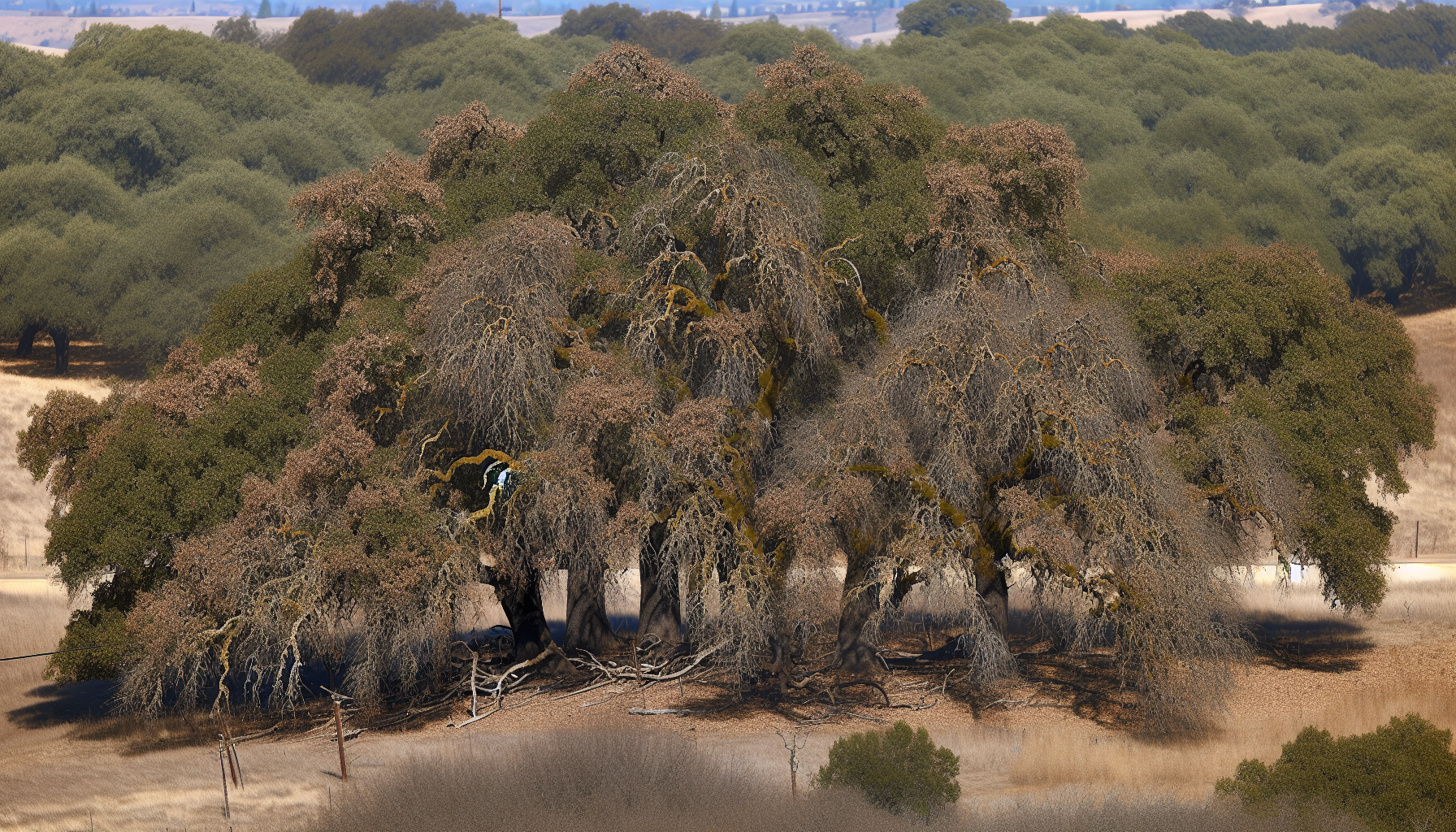
Examining case studies of significant disease outbreaks and their management strategies can be beneficial in combating tree diseases. Introduced pathogens can disrupt the ecological balance and cause widespread tree epidemics, which were historically seen with afflictions such as chestnut blight and Dutch elm disease.
Another notable example is Thousand Cankers Disease, a significant disease for walnut trees, which involves the walnut twig beetle and a canker-producing fungus from the genus Geosmithia. Sudden Oak Death, caused by Phytophthora ramorum, has required extensive study and management within affected forest ecosystems.
Battling Oak Wilt: A War on Multiple Fronts
Oak wilt is a deadly disease affecting oak trees, particularly red oaks, white oaks, and live oaks, causing rapid wilting and browning of their leaves and is responsible for the death of thousands of oaks annually in the eastern United States. The disease spreads from tree to tree through root connections or by insects such as sap-sucking beetles that move spores from infected to healthy trees.
Battling oak wilt is a war fought on multiple fronts. From understanding the disease’s complex life cycle to implementing effective management strategies and leveraging expert resources such as the U.S. Forest Service web page and fact sheets provided by Purdue University and the University of Kentucky.
Loblolly Pine Decline: Unraveling a Complex Syndrome
Loblolly Pine Decline is another significant tree disease. Characterized as a complex syndrome resulting from a combination of biotic and abiotic stressors, unraveling this syndrome is a complex process. Symptomatic Loblolly pines often exhibit decline resembling that of littleleaf disease, suggesting a multifactorial origin.
Factors exacerbating Loblolly Pine Decline, which can also affect ponderosa pine, include:
Prescribed burns
Historical agricultural practices
Sparse underbrush
Significant abiotic pressures such as drought or storm damage
The disease typically affects Loblolly pines over 35 years old, but symptoms of decline can be seen in trees as young as 12 years old.
Preserving Tree Populations: Long-Term Strategies and Research
Protecting tree populations goes beyond merely tackling the direct threats diseases pose. It requires a long-term approach, grounded in ongoing research and the development of innovative strategies. These strategies focus on developing genetic resistance, gene editing, and ecosystem-level approaches to preserve tree populations.
Comprehending the molecular interactions between plants and pathogens is vital to cultivating genetic resistance, the most cost-effective method to safeguard crops. Techniques such as genome editing and cis-genetics could significantly expedite the implementation of resistance strategies that would traditionally take more time or involve genetic engineering.
Advancements in Disease Resistance
The advancements in disease resistance have been significant. Research leveraging genome-wide association studies and transcriptomics is uncovering the interaction between trees and pathogens, speeding up the creation of disease-resistant tree varieties. Gene editing tools, particularly CRISPR-Cas9, are revolutionizing the field by enabling precise modifications in tree genomes to boost resistance against diseases.
Techniques such as NLR capture and heterologous PRR transfer among species are contributing to landscape-scale forest resilience by stacking genes that provide broad disease resistance. Conventional breeding techniques are being used in tandem with genetic engineering to develop genotypes in forest trees that are less susceptible to pests and pathogens.
Ecosystem-Level Approaches
Approaches at the ecosystem level offer an alternative strategy for the preservation of tree populations, including pine species. Planting a diverse selection of native tree species can mitigate the impact of diseases such as oak wilt and support local wildlife, fostering a more robust forest ecosystem. Forests with diverse species and a variety of tree ages exhibit increased resilience against tree diseases, affecting infection dynamics and lowering overall mortality rates.
Active management of ecosystems, ensuring functional diversity, is essential for reducing the prevalence of preventable tree diseases and maintaining long-term forest health. The selection of tree species that are well-adapted to the local environment and not prone to the same tree diseases is a critical aspect of enhancing forest resilience.
Summary
In conclusion, tree diseases are a significant concern, not only for the health of individual trees but also for ecosystems and industries reliant on them. From understanding the culprits behind these diseases to recognizing the symptoms and implementing prevention and control strategies, we have the tools to defend our trees against these threats. Through long-term strategies and ongoing research, we can work towards developing disease-resistant tree varieties and fostering robust, resilient forest ecosystems.
In the face of tree diseases, knowledge is our most powerful weapon. Armed with the information outlined in this blog post, we can all play a role in preserving our tree populations, ensuring their health, and safeguarding the invaluable benefits they provide. Let’s stand up for our trees, for they stand tall for us every day.
Frequently Asked Questions
What is the most common disease for trees?
The most common disease for trees is powdery mildew, which is easily recognized by its white spots or patches with a talcum powder appearance. It is severe in warm, dry weather, with succulent tissue being more susceptible to infection.
How do you detect tree disease?
To detect tree disease, look for leaves or needles with dark spots, unusual colors, or distorted shapes, changes in tree bark, and signs of fungi or root rot. Pay attention to these indicators to identify potential tree diseases.
What is the deadliest tree disease?
The deadliest tree disease is caused by Armillaria mellea, also known as honey fungus. It can infect and kill weakened or healthy trees, posing a significant threat to the tree population.
Can you save a diseased tree?
To save a diseased tree, have a certified arborist assess if the core is rotted, and consider pruning dead limbs, applying pesticides, and fertilizing the roots if necessary. Removing the tree might be the best option if the core is rotted.
What are the main causes of tree diseases?
The main causes of tree diseases include biotic factors like fungi, bacteria, and insects, as well as abiotic factors such as drought and mechanical damage. Biotic factors like fungi, bacteria, and insects, as well as abiotic factors like drought and mechanical damage, are the main causes of tree diseases.



